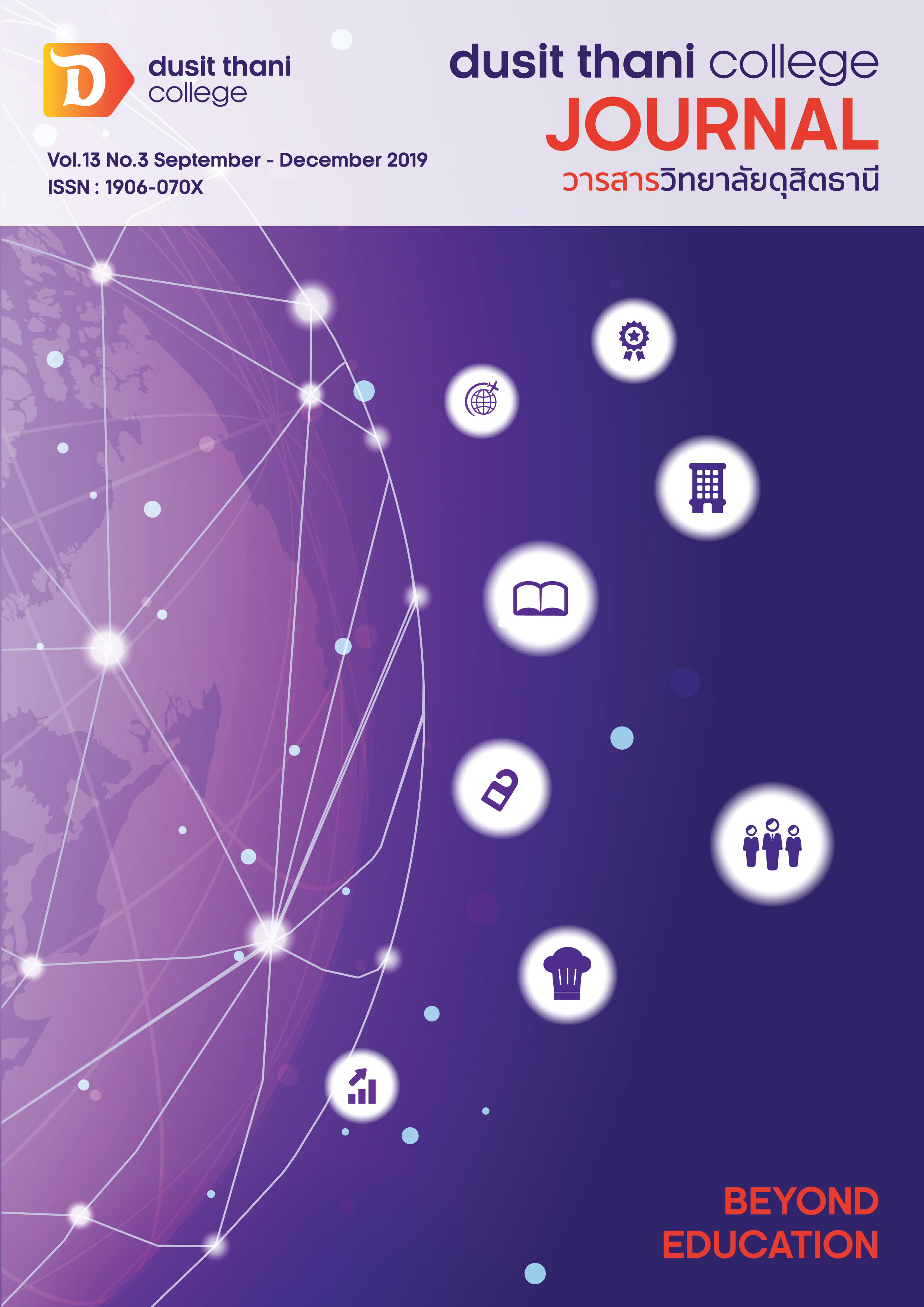The Guideline of the Development of Community-based Tourism Management According to Thailand 4.0 Policy: A Case of Ban Laem Community, Amphoe Bang Pla Ma, Suphanburi Province
Main Article Content
Abstract
The research was aimed 1) to study tourism resources of Ban Laem Community, Amphoe Bang Pla Ma Suphanburi 2) to study potential for tourism of Ban Laem Community, Amphoe Bang Pla Ma Suphanburi according to Thailand 4.0 policy and 3) to study the development of community-based tourism management according to Thailand 4.0 policy: A Case of Ban Laem Community, Amphoe Bang Pla Ma, Suphanburi Province. This research was qualitative research, the tools was the in-depth interview with the key informant to bring the information creating theoretical conclusion and sampling was selected purposively. The results showed that 1) tourism resources of Ban Laem Community, Amphoe Bang Pla Ma, Suphanburi Province are interesting and diverse 2) potential for tourism had 9 dimensions including value of the tourist attraction, accessibility, facilities, environment, limitations of support, reputation, management, activities and processes and community participation and 3) the guideline for the development of community-based tourism management had 3approaches including the potential development and the formulation of community-based tourism management, tourist attraction and creating a knowledge base for the community in terms of tour guide and service skills.
Article Details
Article Screening Policy
- All research and academic articles to be published must be considered and screened by three peer reviews in the relevant field / article.
- All articles, texts, illustrations and tables published in the journal are the personal opinions of the authors. Editors don't always have to agree. And no responsibility whatsoever is the sole responsibility of the author.
- The articles to be published must never be published. Where did you first publish? And not in the consideration of other journals If the audit found that there has been a duplicate publication It is the sole responsibility of the author.
- Any article that the reader sees as being plagiarized or impersonated without reference. Or mislead the work of the author Please let the journal editor know it will be your greatest blessing.
References
2. Ban Laem Subdistrict Municipality. Ban Laem Subdistrict Information Retrieved on June 14, 2018 from http://ban-laem.go.th/public/communities/data/index/menu/163.
3. Boonyasak, Wiwatchai. (1986). Tourism potential. Bangkok.
4. Designated Areas for Sustainable Tourism Administration (2014). Physical environment and community tourism. Bangkok : P2 Design and Printing.
5. Emphan, Dutchanee. (2007). Community tourism development and homestay activities.
Bangkok: Kasetsart University.
6. Isichaikul, Ranee. (2003). Basic knowledge tourism: Sustainable Community Tourism
Management Teaching documents. Nontaburi: Sukhothai Thammathirat Open University.
7. Kaewphoungmai, Siwadol. (2009). Guidelines for sustainable tourism development: a case study of Phu Soi Dao National Park, Uttaradit Province. IS Chiangmai University.
8. Kongthong, Suwannee. (1993.) Public participation in the conservation of community
mangrove forest in Sikao District, Trang Province. Thesis Master Degree. Kasetsart
University, Bangkok.
9. Office of the Prime Minister (2016). Draft of the 20 year national strategic framework (2017-2036).
10. Office of Suphanburi Province. Information of Suphanburi Province Retrieved on June 10,
2018 from http://www.suphanburi.go.th/suphan/.
10. Rojrungsat, Pimrawee. (2010). Community tourism. Bangkok, O.S.Printinghouse.
11. Taesarin, Bovorn. 2017. Thailand 4.0 Why What and How Retrieved on May 1, 2017 from
http://www.drborworn.com/articledetail.asp?id=16223
12. Salobon, Sin. (2003). Tourism by community Concepts and experiences of the northern
region. Chiangmai: The Thailand Research Fund.
13. Sangphikul, Aussawin. (2009). Marketing principles for tourism. 3rd Edition. Bangkok:
Dhurakij Pundit University Press.
14. Sriratu, Wipa. (2008). The potential of ecotourism in Khao Kho District Phetchaboon
Province. Thesis Master of Science Tourism Planning and Management for
Environmental Conservation Srinakharinwirot University.
15. Suansri, Pojjana. (2003). Community Tourism Management Manual. Bangkok : Tourism for Life and Nature Project
16. Sukhothai Thammathirat Open University. (2006). Tourism Resource Management Unit 9-15 2rd Edition. Nonthaburi : Sukhothai Thammathirat Open University Press.
17. The secretariat of the house of representatives. (2016). Thailand 4.0. Bangkok: The secretariat of the house of representatives.
18. Thongma, Weeraphon. (2004). Community Based Tourism : CBT for development of the quality of life of communities in the forest land area Retrieved on June 10, 2018
from www.dnp.go.th/jca16/jile/i49xy4gwqzshj1.doc.
19. Thosamphanmongkon, Sirirat. (2006).Strategic Planning for Sustainable Ecotourism
Development in Tak Province. Thesis Master of Business, Srinakharinwirot University.
20. Udomsri, Jirajet. (2004) Sustainable Ecotourism Management Model: A Case Study of Pong Nam Ron Subdistrict Pong Nam Ron District Chantaburi province. Thesis Master of Arts, Chiang Mai University.
21. Vanitcharittha,Thunyaporn. (2007). Community Knowledge Management: A Case Study of Ecotourism Management with Community Participation Samut Songkhram
Province. Thesis, Silpakorn University.
22. Wongwanitch, Wanna. (2003). Tourism geography. Bangkok : Thammasat University.


